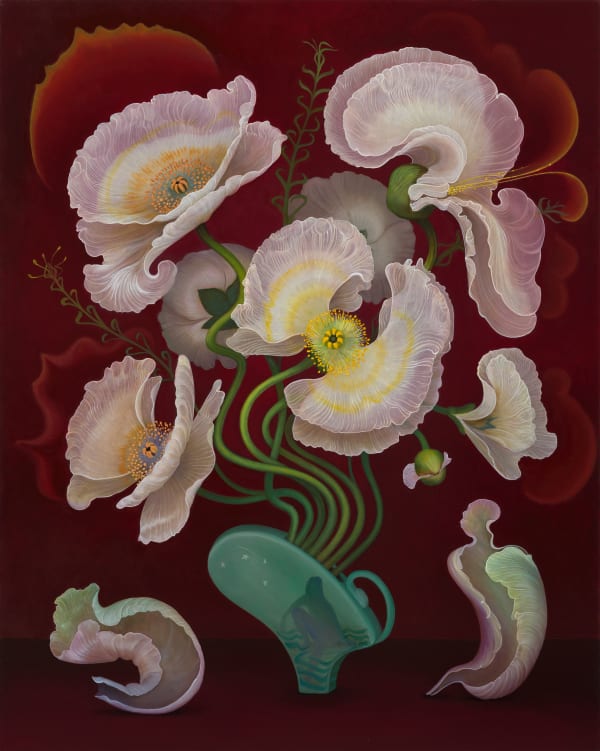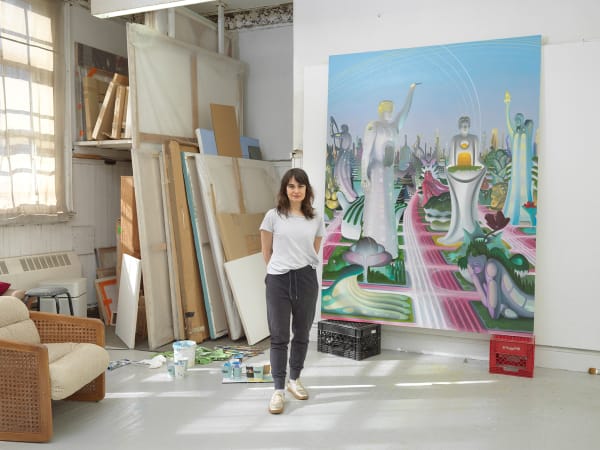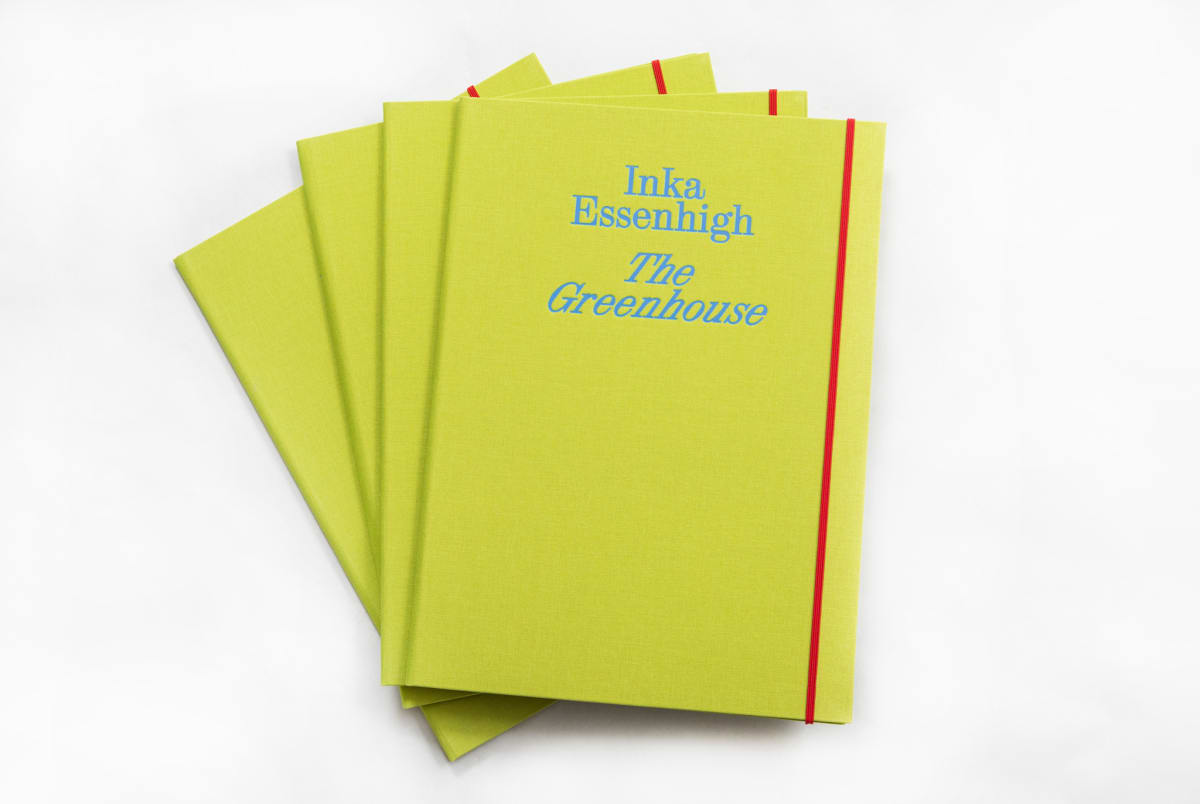Inka Essenhigh: The Greenhouse
Victoria Miro is delighted to present new paintings by Inka Essenhigh. The New York-based artist’s sixth solo exhibition with the gallery comprises a body of work completed during the past year, featuring botanical, landscape and figurative motifs poised between an exuberant exterior world and an energetic interior consciousness.
Inka Essenhigh’s paintings seduce and disarm in equal measure. Each painting is a complete world in itself, impeccably realised, governed by its own logic and in possession of its own narrative. Each has its own ecology and its protagonists – human, floral, or other. Each radiates its own particular quality of light. We recognise aspects of these works implicitly: the pallor of fungal matter; the weight of a poppy’s petal – even if that fungi starts to resemble the woodwind section of a ghostly orchestra or that petal looks to be migrating to human form.
Since the artist first came to prominence in the late-1990s, it could be argued that our knowledge of our surrounding reality, while utterly transformed by the speed and availability of information, has only grown more fraught with technological and ecological change. It is into these uncharted territories of perception that Essenhigh launches this new body of work.
Locating Essenhigh’s painting in time and place has always been part of its challenge and its allure. The artist paints using enamel on canvas, its sheen for her representing freedom from the weight of history. And yet, precisely in its delicacy, its lack of ‘weight’, there lies an undeniable authority. Like the seventeenth-century still life painters, whose powers of verisimilitude tricked the eye into believing not only the veracity of their subjects but that an entire year of organic matter might fruit and flower at the same time (simultaneously cheating death and reminding us of our own mortality), Essenhigh’s facility confers a kind of factual status on whatever she describes – whether animal, vegetable, or mineral and however removed from reality it might at first appear.
At the same time, her virtuoso line – economical and suggestive, full of whiplashes and arabesques – creates a fluid dance within and between her motifs that seems to accentuate a hidden psychological aspect. Matthew Weinstein, writing in the catalogue that accompanied Essenhigh’s 2018 survey exhibition at the Virginia Museum of Contemporary Art, notes that ‘her paintings are not just plant-like in their nature. They are plant-like in actuality. Their attenuated lines follow twists and turns that seem to know where they are going, like vines. We know that vines have a plan, and the plan has urgency… It has a vitality with secret rules. It will not be denied.’
Echoing this, the artist has described wanting to paint ‘what is unseen, to find the life within things and animate them.’ Whether we consider the ‘unseen’, this life force, to be biological or mystical speaks as much to our own temperament as that of the artist. Essenhigh is interested not just in these forces per se but in how and where form (natural or human-made) takes shape around them. Manhattanhenge, a panoramic installation created for The Drawing Center in New York in 2018, drew inspiration from the biannual solstice event in which the rising or setting sun aligns perfectly with Manhattan’s east-west streets; in Essenhigh’s work, architecture gained giddily humanoid attributes. Buildings assume human form, becoming towering, god-like structures in a new cityscape painting, which appears as if a time-lapse of energies – esoteric, ecological or technological – were pulsing through its arteries, the flow of traffic merging with the paths of moon and sun, while plants flourish in artificial light.
If not quite of this world, then which? As these new paintings make clear, resisting easy classification, ultimately Essenhigh’s work addresses the world of painting itself. The artist has talked of a desire to create ‘a contemporary and historic feeling at the same time… where you can sense that a world you’re walking into is primordial but that it also has the feeling of something contemporary and futuristic.’ Her work speaks to painting’s enduring role as a conduit between past, present and future, as well as its singularity in asking fundamental questions about the world we live in while reflecting aspects of it back towards us.
How paintings impress themselves upon us, work themselves into our psyche so profoundly that we see the world through them as much as we recognise the world in them, is perhaps Essenhigh’s overarching concern. Her paintings on one level stand for a blooming consciousness. They prime the senses, heighten awareness, intoxicate and transport, and in doing so awaken in us the desire to look further, question more. We unfurl before them.
About the artist
Born in 1969, Inka Essenhigh lives and works in New York. Recent solo institutional exhibitions include Other Worlds: Inka Essenhigh, Susquehanna Art Museum, Harrisburg, Pennsylvania, USA (2019); Inka Essenhigh: A Fine Line, MOCA Virginia, Virginia Beach, USA (2018) travelling to Kalamazoo Institute of Arts, Michigan, USA (2019); Inka Essenhigh: Manhattanhenge, Drawing Centre, New York, USA (2018).
Her work has been exhibited internationally as part of group exhibitions at venues including Karma, Thomaston, Maine, USA (2024); Speed Art Museum, Louisville, USA; Farnsworth Art Museum, Rockland, USA (2023); the Center for Maine Contemporary Art, Rockland, Maine, USA (2020); USF Contemporary Art Museum, Tampa, FL, USA (2020); American Academy of Arts and Letters, New York, USA (2019); Fondazione Stelline, Milan, Italy (2018); the Frist Center for the Visual Arts, Nashville, USA (2016 and 2012); Museum of Contemporary Art North Miami, USA (2013); Dayton Art Institute, OH, USA (2011); Center for Maine Contemporary Art, Rockport, USA (2011); Museum of Modern Art, New York, USA (2007); The Royal Academy of Art, London, UK (2006); Domus Artium 2, Salamanca, Spain (2005); São Paulo Biennale, Brazil (2004); Museum of Contemporary Art, North Miami, USA (2003) and the Fruitmarket Gallery, Edinburgh, UK (2003).
Essenhigh’s work is in the collections of major museums including Albright-Knox Art Gallery, Buffalo, NY, USA; Denver Art Museum; Minneapolis Institute of Art, Minneapolis, USA; Museum of Contemporary Art, North Miami, USA; Museum of Modern Art / P.S.1 Center for Contemporary Art, New York, USA; San Francisco Museum of Modern Art, USA; Seattle Art Museum, USA; Tate, London, UK; Virginia Museum of Fine Art, Richmond, USA and Whitney Museum of American Art, New York, USA.
-

George Saunders’ essay for Inka Essenhigh: The Greenhouse features in The Paris Review
March 25 2025'The value of a master like Inka Essenhigh is, it seems to me, that she can assist us in the virtuous slowing-down of visual perception.'Read More -

Inka Essenhigh is interviewed by Plus Magazine
March 19 2025'For me, painting needs to feel good—just like nature feels good. I see art as a way to transform how we experience the world.'Read More

